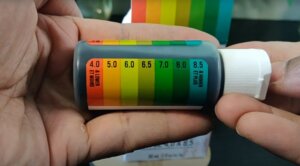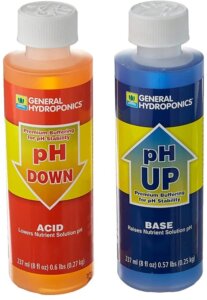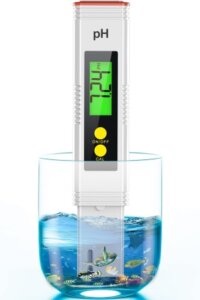When deciding whether to monitor pH levels in your semi-hydroponic system, there are several factors to consider.
Here is an in-depth analysis of what you should think about.
Step-by-Step Guide: How to Test pH Levels in Semi-Hydro System

Testing the pH of your semi-hydroponic system is simpler than it sounds.
Here’s a beginner-friendly guide to get you started:
- Choose Your pH Test Kit: You can opt for litmus paper strips, a liquid pH test kit, or a digital pH meter. Digital meters provide more accurate readings and are relatively easy to use.
- Collect a Water Sample: From your semi-hydroponic system, take a small sample of the nutrient solution in a clean cup or container.
- Test the pH: If using a digital meter, simply turn it on and insert the probe into the water sample. For test strips or liquid kits, follow the manufacturer’s instructions. Generally, you’ll dip the strip into the water or add a few drops of the testing solution to your sample.
- Read the Results: Digital meters will display the pH value on their screen. For strips, compare the color change to the chart provided with your kit. Liquid tests will change the color of the sample, which you’ll also compare to a color chart.
- Adjust as Needed: Based on your reading, you may need to adjust the pH to fit your plants’ specific needs.
General Hydroponics pH Control Kit for a Balanced Nutrient Solution
- Complete Solution: The General Hydroponics pH Control Kit includes everything for pH measurement in hydroponic systems.
- Accurate & Fast: Delivers reliable results quickly and effortlessly.
- Kit Contents: Features pH Up and pH Down liquids (8 oz. each), 1 oz. Test Indicator, test tube, eyedropper, and pH chart.
- Grower Preferred: Chosen for its ease of use and reliability over electronic meters.
- Simple Usage: Just mix nutrient solution with a few drops of indicator in the test tube to read pH. Ideal range is 5.5 to 6.5.
DIY Solutions for Adjusting pH
Sometimes, the pH of your nutrient solution needs a little tweaking. Here’s how you can adjust it using household items:
- To Lower pH: Add a small amount of vinegar to your nutrient solution. Start with one teaspoon per gallon of water, mix well, and retest the pH. Repeat if necessary, but add slowly to avoid drastic changes.
- To Raise pH: Dissolve baking soda in water (about one teaspoon per gallon) and mix it into your nutrient solution. Test and adjust as needed.
If you just want to make it simple and more straightforward, we recommend using the General Hydroponics pH Control Kit above.
Incorrect pH levels can lead to nutrient lockout, where plants cannot absorb nutrients efficiently, leading to deficiencies. Signs include yellowing leaves, stunted growth, and poor yield.
If you notice these, check and adjust your pH levels immediately. Regular monitoring can prevent these issues from arising.
PH Meter/Tester
- High Accuracy: pH meter with 0-14.0 range and ±0.01 precision.
- Easy Calibration: Automatic calibration with 3 included pH powder packets.
- Temperature Compensation: Accurate readings across 0°C-60°C with ATC.
- Broad Application: Suitable for water, pools, aquariums, hydroponics, and more.
- Portable: Lightweight, includes carrying case and calibration packets.
- Maintenance Tip: Keep the electrode covered to protect accuracy.
- Accurate & Fast: Delivers reliable results quickly and effortlessly.
Recommended pH Levels for Different Houseplants
| Houseplant Type | Preferred pH Range |
|---|---|
| Monstera | 5.5 – 7.0 |
| Alocasia | 5.5 – 6.5 |
| Colocasia | 5.5 – 7.0 |
| Philodendron | 5.0 – 6.0 |
| Snake Plant (Sansevieria) | 6.0 – 6.5 |
| ZZ Plant | 6.0 – 7.0 |
| Pothos | 6.1 – 6.5 |
| Spider Plant | 6.0 – 6.5 |
| Peace Lily | 5.8 – 6.5 |
| Rubber Plant | 5.5 – 7.0 |
| Fiddle Leaf Fig | 6.0 – 7.0 |
| Calathea | 6.0 – 7.0 |
| Anthurium | 5.5 – 6.5 |
| Fern | 5.0 – 5.5 |
These plants generally prefer slightly acidic to neutral soil conditions. The right pH level is crucial for their ability to uptake nutrients effectively, ensuring lush growth and vibrant health. To maintain the optimal pH, you may need to periodically test your soil or potting mix and adjust as necessary using amendments like sphagnum peat (to lower pH) or lime (to raise pH). Remember, it’s always best to adjust pH gradually to avoid stressing the plants.
Maintain stable pH levels by:
- Regularly checking the water source’s pH, as it can vary seasonally.
- Being mindful of how different nutrients can affect pH levels when added to your solution.
- Using a buffer solution to help stabilize pH changes.
The Benefits of Monitoring pH
Monitoring the pH of your semi-hydroponic system is highly beneficial. The pH level is crucial as it affects nutrient availability and overall plant health. However, pH levels are not constant; they fluctuate due to various factors like temperature, CO2 levels, and the presence of different media or buffers.
This variability means that the pH can vary across containers, influenced by factors such as the time of day, location, type of water used, and the amount of fertilizer.
While regular pH testing is practical and beneficial in large-scale, active semi-hydroponic systems where many plants share a single reservoir, it becomes more challenging in semi-hydroponics. In passive systems, individual containers often house different plant types with unique pH needs, making regular testing a complex and potentially tedious task.
Personal Insights and Practicality
From personal experience, I’ve found that regularly checking pH levels in my passive hydroponic setups is not necessary.
My setups are outdoor in a tropical climate, where environmental conditions can change drastically within a single day.
Considering the large number of plants and the use of tap water (sometimes mixed with rainwater) and dry fertilizers, consistent pH monitoring would be impractical for my circumstances.
To Monitor or Not to Monitor pH
The decision to monitor pH in your semi-hydroponic system is a personal one. If you choose to proceed, it’s important to do so diligently—checking before and after fertilization, at different times of the day, and on a regular schedule.
However, based on my experience, while informative, pH testing is not strictly necessary for successful semi-hydroponic system.
Your decision should reflect your gardening style, the scale of your setup, and your willingness to engage in the additional work that pH monitoring requires.
Understanding pH Dynamics in Semi-Hydroponics
Navigating the dynamics between pH levels and environmental factors is intriguing. Here’s a simplified overview:
- CO2 and pH: An increase in CO2 levels decreases pH, making the environment more acidic.
- Photosynthesis: Photosynthesis increases O2 levels as CO2 decreases, leading to a more alkaline pH.
- Respiration: During non-photosynthetic periods, O2 levels drop and CO2 increases, lowering the pH.
- Temperature: Higher temperatures decrease CO2 solubility, leading to a higher pH, while lower temperatures have the opposite effect.
- Carbonate and Bicarbonate: Higher concentrations increase the pH level.
- Decomposition: Decomposition of organic material increases carbon, raising CO2 levels and lowering pH.
The Enjoyable Aspect of pH Monitoring
Beyond its scientific and maintenance roles, monitoring and adjusting pH levels can add a fun dimension to your semi-hydroponic system. Some plants, like hydrangeas, offer visual cues to pH changes through color shifts in their flowers, ranging from blue or purple in acidic conditions to red or pink in alkaline environments. This not only adds beauty to your garden but also serves as a natural pH indicator.
My own hydrangeas have showcased a spectrum of colors, including a unique yellowish/off-white, all due to pH level variations.
This playful interaction with your plants highlights the importance of pH management for plant health and nutrient uptake, offering an extra layer of enjoyment to your gardening experience.
Whether you’re new to semi-hydroponic or an experienced green thumb, understanding and potentially monitoring pH levels can enhance your gardening success and enjoyment.



